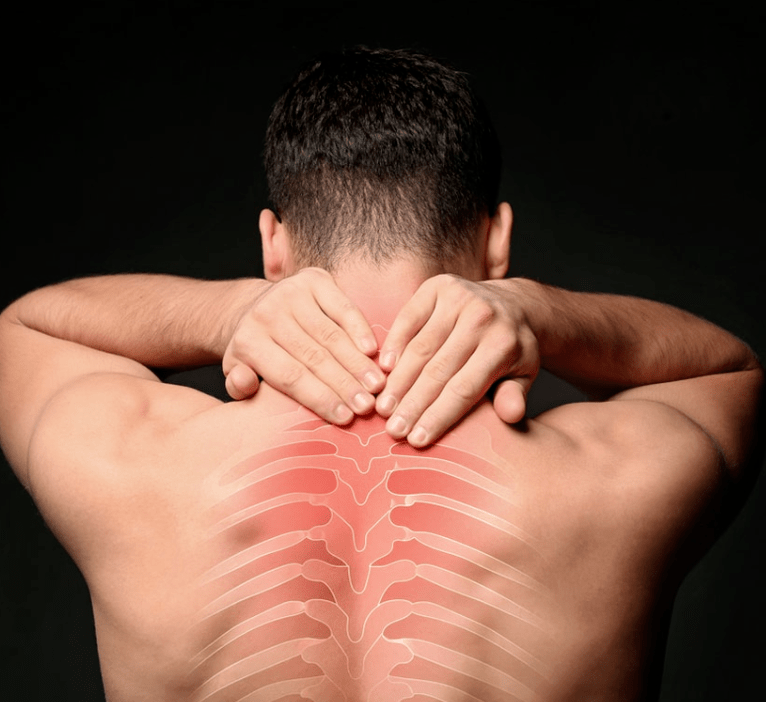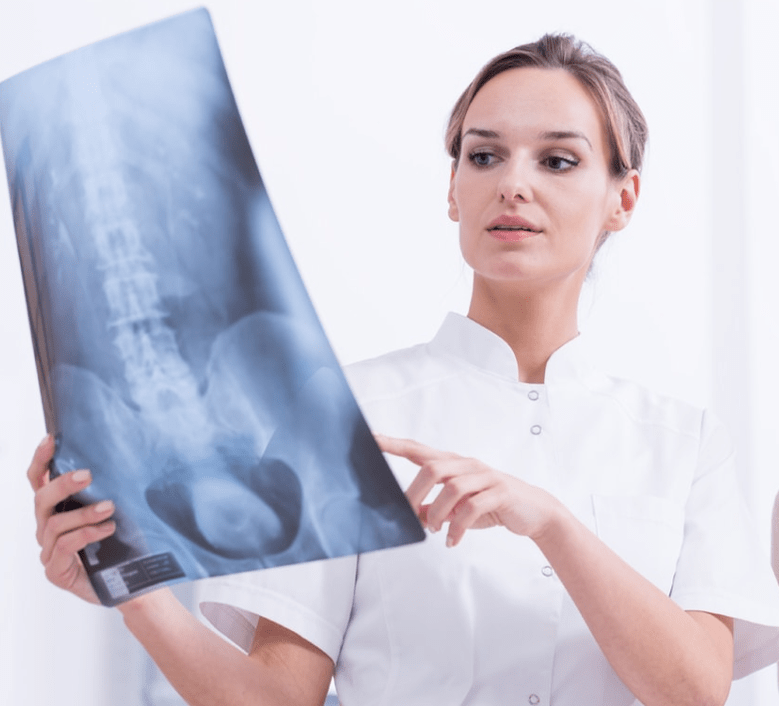
Osteochondrosis is the most common disease among all spinal diseases. Since osteochondrosis is directly a dystrophic degenerative disease of the intervertebral disc located between the vertebrae, it will cause irreversible changes in its structure and the shape of the intervertebral disc itself that constitutes the thoracic vertebrae.
As a person grows older, these changes in his spine will increase. By the age of 40-45, almost everyone will suffer from spinal osteochondrosis. On its own, the frequency of thoracic osteochondrosis is much lower than that of the lumbar or cervical spine, because the vertebrae have much lower mobility than other vertebral regions. In addition, the back area of the chest has more developed muscle bundles, which supports the spine in the chest area better than other areas.
What kind of thoracic osteochondrosis is this?
Thoracic osteochondrosisIt directly represents the delamination of the intervertebral discs between the vertebrae, and their thickness is reduced. Therefore, the nerve endings located in the intercostal area of the human chest are subsequently squeezed.
However, we noticed once again that the spine in the chest area is the least susceptible to osteochondrosis due to the rigidity of the physiological fixation of the human ribs. Thoracic osteochondrosis is a rare phenomenon, such as cervical or lumbar osteochondrosis.
Generally, the pathological process of thoracic osteochondrosis involves the intervertebral discs between the thoracic vertebrae, including twelve thoracic vertebrae. But the most common is osteochondrosis in the thoracic spine, and the pathological changes occur in the upper thoracic spine. Thoracic spine osteochondrosis has various degrees of pathology, and we will discuss them in further detail.
Inducing factors of thoracic osteochondrosis
Modern science has not yet fully determined the exact cause of thoracic osteochondrosis. At present, it is customary in medicine to distinguish the following predisposing factors, or so-called risk factors, because thoracic osteochondrosis of the spine occurs:
- Genetic predisposition
- Excessive physical activity in this part of the spine;
- Spinal injuries, such as falls or bruises on the chest;
- The changes of the intervertebral discs with age, leading to the reduction of the hydration of the intervertebral disc tissues;
- Violation of the blood supply to the chest area.
Causes of thoracic osteochondrosis
In general, the development of osteochondrosis is usually promoted by lack of motivation, that is, lack of muscle load, which leads to the weakening of the function of the muscle corset, which results in an increase in muscle load. Intervertebral discs and ligaments.
Other causes of thoracic osteochondrosis are:
- Hypothermia;
- There is a chronic stress situation;
- Transfer infection
- Arduous physical labor conditions;
- Hormonal imbalance in the body;
- Violation of metabolic processes in the body;
- The presence of congenital defects in the spine, that is, its thoracic region.
In the process of being exposed to a combination of these factors (sometimes even one), over time, the intervertebral discs between the vertebrae will experience malnutrition-degenerative irreversible processes:
- The nucleus pulposus of the intervertebral disc gradually loses fluid, which secretes to provide lubrication function, and finally significantly reduces the damping function of the intervertebral disc;
- The fibrous annulus of the vertebra itself becomes more fragile due to its increased load, which in turn leads to its gradual destruction.
Symptoms and signs of spine thoracic osteochondrosis
The clinical symptoms of thoracic osteochondrosis completely depend on the following factors:
- The age of the patient;
- Disease severity
- Stages of thoracic osteochondrosis: remission or worsening.
The main symptoms of thoracic osteochondrosis are:
- Spinal chest pain, the so-called back pain;
- Painful injury of the nerve endings of the spinal cord-radiculopathy;
- Abdominal syndrome;
- Heart syndrome or myocardial changes, even under the influence of trinitroglycerin, there will continue to have characteristic pain;
- Pulmonary syndrome, manifested as stagnation in the lungs, accompanied by signs of hypoxia, that is, asphyxia.
No elevated body temperature was observed in patients with thoracic osteochondrosis, which is also a direct sign of differential diagnosis. Chest back pain is one of the main symptoms of osteochondrosis, indicating cracks in the annulus fibrosus and deformation of the nucleus pulposus. When palpating, the pain in this area of the chest will only increase, and the symptoms will get worse.
In addition, the characteristic symptoms of thoracic osteochondrosis with compressive myelopathy, that is, the deformation of nerve endings, include:
- Feeling of "goose bumps"-paresthesia;
- Pain along the compressed nerve-a common symptom;
- Reduced sensitivity to temperature and touch;
- Spinal dysfunction is also one of the characteristic symptoms.
After you find such symptoms, you need to see a specialist. The appearance and intensity of symptoms in the complex is particularly dangerous. At the same time, it is not appropriate to prescribe the right medicine without eradicating the causes and factors.
The extent of thoracic osteochondrosis
Each degree of thoracic osteochondrosis has its own pathological characteristics, and only has its own clinical symptoms. Modern medicine divides the degenerative disc disease in the chest area into four levels (similarly-degenerative disc disease of the lumbar and cervical spine), and therefore distinguish the four stages of its development. Let us consider them in more detail.
The first level,It is characterized by cracks in the annulus fibrosus, followed by penetration of the nucleus pulposus. This developmental period of thoracic osteochondrosis is characterized by the following symptoms:
- Pain in the spine that does not exceed the location of the lesion;
- These pains can be permanent or can manifest as low back pain;
- There may be spastic contraction of the chest muscles, accompanied by pain in the heart area.
Second degreeThe development of thoracic osteochondrosis is characterized by increased intervertebral mobility that occurs pathologically, with the following clinical manifestations:
- Subluxation of the thoracic spine;
- Pain worsens during exercise;
- Prolonged posture will cause discomfort.
Three degreesIt is characterized by the rupture of the annulus fibrosus and the exit of the nucleus pulposus exceeding its limit. During this period of thoracic osteochondrosis, intervertebral hernias began to appear, and the clinical symptoms were quite serious. Namely-neurovascular, muscle rigidity and reflex dystrophy.
In addition to the above, for the third degree osteochondrosis of the thoracic spine, changes in the following conditions of the spine are characteristic:
- The position of the spine is not firmly fixed;
- The movement of the spine area is limited, manifested as kyphosis or scoliosis.
Fourth degree-Malnutrition-The degenerative process has affected all structures around the spine. This pathological process involves the yellow ligament, interspinous ligament and other ligaments, and fibrosis occurs in the structures around the spine. During this period of thoracic osteochondrosis, the so-called remission state is clinically observed.
complication
With the further development of thoracic osteochondrosis, the following complications may occur:
- Inflammation of the nerve endings of the spinal cord;
- The occurrence of intervertebral hernia;
- The development of vascular dystonia;
- The development of Schmorl's hernia;
- Spondyloarthropathy;
- Pathological growth of bone growth-osteophytes;
- The spinal canal is significantly reduced.
It should be pointed out that the severity of the complications of thoracic osteochondrosis depends entirely on the progress of the disease, and of course, it also depends on the effectiveness of the treatment of thoracic osteochondrosis.
Diagnosis and its methods

In practice, there are several methods used to diagnose thoracic osteochondrosis. Among them, the most common is X-ray examination, the results of which are very useful. The signs of thoracic osteochondrosis detected in this study are as follows:
- The contour of the intervertebral disc between the vertebrae is destroyed;
- The edge of the skin board has a wavy shape;
- The intervertebral discs change their shape;
- The appearance of osteophytes-pathological growth of bones in the spine;
- The hook-like protrusions of the vertebrae increase and become pointed;
- The body of the thoracic spine has changed their normal shape;
- The height of the intervertebral disc between the vertebrae is significantly reduced;
- A herniated disc formed between the vertebrae.
In some cases, the method of diagnosing osteochondrosis of the thoracic spine is practiced through X-ray comparative studies, which identify the following signs of this disease:
- In the case of advanced pathology, the contrast agent completely fills the intervertebral discs between the vertebrae;
- With the help of contrast agent, the contour of the nucleus pulposus can be seen, which is uneven;
- When the intervertebral disc is destroyed, a large amount of contrast agent penetrates beyond its limit until it penetrates into the spinal canal.
Only the correct diagnosis can determine the correct treatment.
Treatment of osteochondrosis
Considering the diagnosis result of sternal osteochondrosis, sternal osteochondrosis can be treated in one of the following ways, namely:
- Conservative traditional treatment of the spine;
- Traction treatment of chest osteochondrosis;
- Surgical intervention.
The treatment of thoracic osteochondrosis is called conservative treatment, and it is very complicated to treat any type of osteochondrosis: drugs, physical therapy, physical therapy exercises. Non-steroidal anti-inflammatory drugs are designed to relieve spinal pain known for thoracic osteochondrosis. It should be pointed out that these drugs can well eliminate the inflammatory process and the resulting swelling and help reduce nerve root compression. In more complicated cases of breast osteochondrosis, the attending doctor may prescribe additional drugs, such as some effective painkillers and muscle relaxants, which can prevent muscle cramps from occurring.
When the pain subsides or manages to stop, that is, during the remission period, physical therapy is performed, in addition to exercise therapy and massage. These are all important parts of comprehensive treatment. One of the main physical therapy tools used to treat and prevent diseases is pulse magnetic therapy, which uses special medical equipment for clinical and home use.
When the condition worsens, only magnetic therapy with special parameters is allowed; there are medical equipment for the treatment of acute and chronic pain. The system is also suitable for the treatment of lumbosacral and cervical spine.
In addition to the above, traction therapy, that is, the treatment of thoracic osteochondrosis through special traction, can be successfully used to treat thoracic spine osteochondrosis. In this way, the paravertebral muscles, tissues and ligaments are stretched, resulting in an increase in the distance between the vertebrae. Even one and a half millimeters is enough to reduce swelling, eliminate compression, and relieve tension in the muscles near the spine. In any case, the main principle of conservative treatment is its complexity. Treatment will have to be done for a long time and on a regular basis. This is the only way to hope for results.
However, only when the above-mentioned methods of treating thoracic osteochondrosis have not achieved the expected results, surgical intervention is recommended as a treatment for osteochondrosis.






































